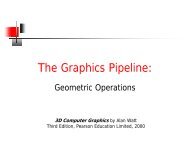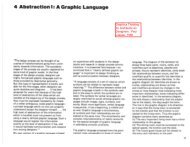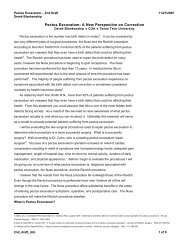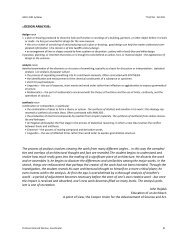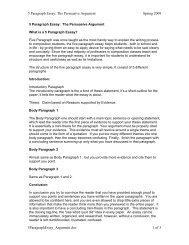The Eyes of the Skin
The Eyes of the Skin
The Eyes of the Skin
You also want an ePaper? Increase the reach of your titles
YUMPU automatically turns print PDFs into web optimized ePapers that Google loves.
Beyond architecture, contemporary culture at large drifts towards adistancing, a kind <strong>of</strong> chilling de-sensualisation and de-eroticisation <strong>of</strong> <strong>the</strong>human relation to reality Painting and sculpture also seem to be losing<strong>the</strong>ir sensuality; instead <strong>of</strong> inviting a sensory intimacy, contemporaryworks <strong>of</strong> art frequently signal a distancing rejection <strong>of</strong> sensuous curiosityand pleasure. <strong>The</strong>se works <strong>of</strong> art speak to <strong>the</strong> intellect and to <strong>the</strong>conceptualising capacities instead <strong>of</strong> addressing <strong>the</strong> senses and <strong>the</strong>undilTerentiated embodied responses. <strong>The</strong> ceaseless bombardment <strong>of</strong>unrelated imagery leads only to a gradual emptying <strong>of</strong> images <strong>of</strong> <strong>the</strong>iremotional content. Images are converted into endless commoditiesmanufactured to postpone boredom; humans in turn are commodified,consuming <strong>the</strong>mselves nonchalantly without having <strong>the</strong> courage or even<strong>the</strong> possibility <strong>of</strong> confronting <strong>the</strong>ir very existential reality We are madeto live in a fabricated dream world.I do not wish to express a conservative view <strong>of</strong> contemporary art in<strong>the</strong> tone <strong>of</strong> Hans Sedlmayr's thought-provoking but disturbing book Artin Crisis.G5 I merely suggest that a distinct change has occurred in oursensory and perceptual experience <strong>of</strong> <strong>the</strong> world, one that is reOected byart and architecture. If we desire architecture to have an emancipatingor healing role, instead <strong>of</strong> reinforcing <strong>the</strong> erosion <strong>of</strong> existential meaning,we must reOect on <strong>the</strong> multitude <strong>of</strong> secret ways in which <strong>the</strong> art <strong>of</strong>architecture is tied to <strong>the</strong> cultural and mental reality <strong>of</strong> its time. \Veshould also be aware <strong>of</strong> <strong>the</strong> ways in which <strong>the</strong> feasibility <strong>of</strong> architectureis being threatened or marginalised by current political, cultural, economic,cognitive and perceptual developments. Architecture hasbecome an endangered art form.paintings <strong>of</strong> Hieronymus Bosch and Pietel' Bruegel, for instance, alreadyinvite a participatory eye to travel across <strong>the</strong> scenes <strong>of</strong> multiple events.<strong>The</strong> 17th-century Dutch paintings <strong>of</strong> bourgeois life present casual scenesand objects <strong>of</strong> everyday use which expand beyond <strong>the</strong> boundaries <strong>of</strong> <strong>the</strong>Albertian window. Baroque paintings open up vision with hazy edges,s<strong>of</strong>t focus and multiple perspectives, presenting a distinct, tactile invitationand enticing <strong>the</strong> body to travel through <strong>the</strong> illusory space.An essential line in <strong>the</strong> evolution <strong>of</strong> modernity has been <strong>the</strong> liberation<strong>of</strong> <strong>the</strong> eye from <strong>the</strong> Cartesian perspectival epistemology <strong>The</strong> paintings <strong>of</strong>Joseph MallOI'd William Turner continue <strong>the</strong> elimination <strong>of</strong> <strong>the</strong> pictureframe and <strong>the</strong> vantage point begun in <strong>the</strong> Baroque era; <strong>the</strong> Impressionistsabandon <strong>the</strong> boundary line, balanced framing and perspectival depth;Paul Cezanne aspires 'to make visible how <strong>the</strong> world touches us';GGCubistsabandon <strong>the</strong> single focal point, reactivate peripheralvision and reinforcehaptic experience, whereas <strong>the</strong> colour field painters reject illusory depthin order to reinforce <strong>the</strong> presence <strong>of</strong> <strong>the</strong> painting itself as an iconic artifactand an autonomousreality Land artists fuse <strong>the</strong> reality <strong>of</strong> <strong>the</strong> workwith <strong>the</strong> reality <strong>of</strong> <strong>the</strong> lived world, and fInally, artists such as Richard Serradirectly address <strong>the</strong> body as well as our experiences <strong>of</strong> horizontality andverticality, materiality, gravity and weight.<strong>The</strong> same countercurrent against <strong>the</strong> hegemony <strong>of</strong> <strong>the</strong> perspectivaleye has taken place in modern architecture regardless <strong>of</strong> <strong>the</strong> culturallyprivileged position <strong>of</strong> vision. <strong>The</strong> kines<strong>the</strong>tic and textural architectureFrank Lloyd Wright, <strong>the</strong> muscular and tactile buildings <strong>of</strong> Alvar Aalto,and Louis Kahn's architecture <strong>of</strong> geometry and gravitas are particularlysignificant examples <strong>of</strong> this.<strong>of</strong><strong>The</strong> Rejection <strong>of</strong> Alberti's Window<strong>The</strong> eye itself has not, <strong>of</strong> course, remained in <strong>the</strong> monoculal~ fIxed constructiondefined by Renaissance <strong>the</strong>ories <strong>of</strong> perspective. <strong>The</strong> hegemoniceye has conquered new ground for visual perception and expression. <strong>The</strong>A New Vision and Sensory BalancePerhaps, freed <strong>of</strong> <strong>the</strong> implicit desire <strong>of</strong> <strong>the</strong> eye for control and power, itis precisely <strong>the</strong> unfocused vision <strong>of</strong> our time that is again capable <strong>of</strong>opening up new realms <strong>of</strong> vision and thought. <strong>The</strong> loss <strong>of</strong> focus brought34THE EYES OFTHE SKINPART I 35






